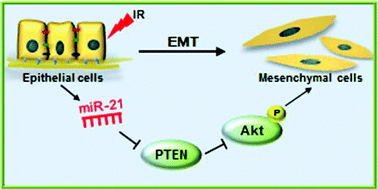MiRNA-21 functions in ionizing radiation-induced epithelium-to-mesenchymal transition (EMT) by downregulating PTEN†
Abstract
Radiation-induced pulmonary fibrosis (RIPF) results from thoracic radiotherapy and severely limits the use of radiotherapy. Recent studies suggest that epithelium-to-mesenchymal transition (EMT) contributes to pulmonary fibrosis. Although miRNA dysregulation participates in a variety of pathophysiologic processes, their roles in fibrotic lung diseases and EMT are unclear. In this study, we aimed to identify key miRNAs involved in this process using a mouse model of RIPF previously established by irradiation with a single dose (20 Gy) of 60Co γ-rays. At 2-weeks post-irradiation, a set of significantly upregulated miRNAs was identified in lung tissue by miRNA array analysis. This included miR-21, which has been reported to contribute to the pulmonary fibrotic response induced by stereotactic body radiotherapy. Here, we showed that miR-21 expression increased in parallel with EMT progression in the lungs of irradiated mice. Ectopic miR-21 expression promoted EMT progression in lung epithelial cells. Furthermore, downregulation of miR-21 expression by transfection of its inhibitor inhibited ionizing radiation (IR)-induced EMT. Knockdown of PTEN, which is the functional target of miR-21, reversed the attenuation of IR-induced EMT mediated by miR-21 downregulation. Radiation treatment decreased PTEN expression and increased Akt phosphorylation; these effects were abolished by the miR-21 inhibitor. MiR-21 overexpression in lung epithelial cell also downregulated PTEN expression and upregulated Akt phosphorylation. In conclusion, we have demonstrated that miR-21 functions as a key regulator of IR-induced EMT in lung epithelial cells via the PTEN/Akt pathway. Targeting miR-21 is implicated as a novel therapeutic strategy for the prevention of RIPF.



 Please wait while we load your content...
Please wait while we load your content...